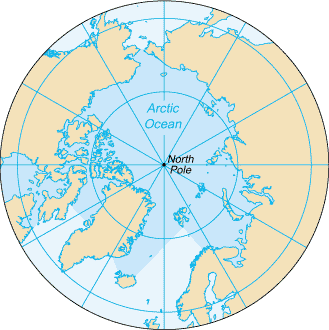
INTERESTING FACTS ABOUT THE ARCTIC OCEAN !!!
The Arctic Ocean is located in the extreme North Polar Region. It is almost in a circular shape, with the North Pole just about at its center.
The Arctic Ocean is the shallowest and smallest of the world’s five major oceans.
The five oceans from smallest to largest are the Arctic Ocean, Southern Ocean, Indian Ocean, Atlantic Ocean and the Pacific Ocean.
The five oceans are all connected together and divided up by the world’s seven continents.
The Arctic Ocean covers less than 3% of the Earth’s surface.
Water is vital to all forms of life, and it is most likely that life on Earth began in the oceans. Oceans also make life on land possible, so without them, humans could not exist.
Earth also has smaller bodies of water that are partly enclosed by land, called the seas. The three largest seas are the Caribbean Sea, the Mediterranean Sea and the South China Sea.
The climate of the Arctic is best described by long, cold winters and short, cool summers.
The Arctic receives 24 hours of sunlight each summer, but 24 hours of darkness each winter, due to the Earth’s tilt.
The Arctic Ocean has freezing temperatures as it lies at the extreme Polar Region.
Average temperatures of the Arctic surface water range from 28.6°F to 30.2°F.
The Arctic Ocean gets it name from the word “arktos,” which means “bear” in Greek.
The Arctic Ocean is split into two major ridges, the Eurasian Ridge and the North American Ridge.
The length of the Arctic coastline is estimated to be 45,500 km (25,200 miles).
The deepest part of the Arctic Ocean is called the Litke Deep, at 17,880 feet below sea level.
The area covered by the Arctic Ocean is 14 million sq km, or 5.4 million sq miles.
The average depth of the Arctic Ocean is 990 meters, or 3,248 feet.
Much of the Arctic Ocean is covered in ice, however the thickness of the ice varies on what time of season it is. The ice thickens in April and becomes relatively thinner in September.
Icebergs and Ice packs will be found in the Arctic Ocean during any season, however, because of the increasing temperatures of the ocean waters due to global warming, more ice packs and icebergs are melting during the summer, and less water is freezing in winter every year.
In the Arctic Ocean, the sea freezes where it is in contact with the extremely cold air. The ice floats at the surface instead of sinking to the ocean floor, because it is 9% less dense than water. In other words, water is heavier than ice. The ice can cover large areas of the ocean.
If all the ice in the Arctic melted, the global sea level would rise 24 feet.
The ocean water under the Arctic ice is cold, but still warmer than the ice.
The speed at which the ice drifts is estimated at 1 to 4 cm per second.
The Arctic Ocean touches three continents, North America, Asia and Europe.
The countries to border the Arctic Ocean include, Canada, Russia, Norway, Iceland, Greenland and the United States.
Some of the well know islands in the Arctic Ocean include, Greenland Island, Hyde Parker Island, Crescent Island, Shoe Island, Monumental Island and Hudson Island.
There are many island groups in the Arctic that consist of thousands of islands each.
The first person to cross the Arctic Ocean by boat was Fridtjof Nansen in 1896.
In 1969, Wally Herbert, led the first surface crossing of the ocean with a dog sled expedition, from Alaska to Svalbard.
The Arctic is ocean surrounded by land, while the Antarctic is land surrounded by ocean.
The Arctic’s ice is rather thin compared with Antarctica, and it has water, not land, under it.
The Arctic is almost entirely covered by water, most of which is frozen. The ice of the Arctic, including the glaziers and icebergs, contains about 15% of the world’s fresh water.
The Arctic Ocean has many natural resources, including petroleum, natural gas fields and placer deposits.
Since 1937, Russian manned drifting ice stations have been monitoring the Arctic Ocean.
Because the Arctic Ocean may hold 25% or more of the world’s undiscovered oil and gas resources, it has led to a dispute between the United States, Russia, Canada, Norway and Denmark.
Icebergs in the Arctic Ocean, occasionally break away from glaciers in western Greenland and extreme northeastern Canada, posing a hazard to ships. The Titanic is the most famous one of all.
When summer arrives in the Arctic Ocean, it brings almost constant daylight, warming the ground. The surface layers of ice thaw out and trigger an explosion of marine life.
Polar bears live and hunt on the ice of the Arctic Ocean, and live only in this landscape.
The animals that hunt or breed on the sea ice in the Arctic Ocean are at most risk from extinction, as the ice is shrinking each year. If global warming continues at the rate it is, scientists reckon the sea ice in the Arctic could disappear completely by 2070. The most vulnerable animal is the polar bear, who is specialized for hunting on the sea ice, so if the sea ice vanishes, the polar bear may vanish with it.
The Arctic Ocean is an unlikely home of many different creatures, apart from whales, seals and walruses you can also find arctic wolves, arctic foxes, murres prosper, brown bears and polar bears.
Endangered marine species in the Arctic Ocean include walruses and whales.
In the Arctic Ocean, there are four different type of whale species, including the grey whale, beluga whale, narwhal whale and the bowhead whale.





